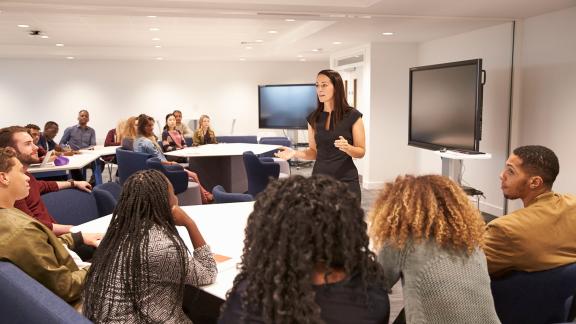Having an effective communications approach for reward with help you with recruitment and retention by:
Maximising the impact of your reward offer to successfully achieve your strategic goals.
Demonstrating your commitment and investment in your staff.
Helping staff to fully appreciate and understand the value of working for your organisation.
Reinforcing your organisational values and unique employer brand.

Evidence tells us that many NHS employees are not aware of the range of rewards and benefits offered by their employer. It’s therefore important to make the most of what you’re offering and how you are communicating it.
Benefits of working together
It is important to involve key stakeholders when planning your reward communications.
Other teams and departments could offer assistance to promote a wider understanding of the campaign and provide extra support. Establishing positive working relationships from the start will help you gain ongoing support.
Key stakeholders:
- communications team
- staff side
- line managers
- senior management team.
Communications colleagues can provide feedback and suggestions on:
- creating a communications plan
- target audience
- key messages
- style and tone
- timescales
- social media
- other resources you may need (such as a
- photographer or designer).
Involving other departments such as health and wellbeing, occupational health, diversity and inclusion and recruitment, in the planning stages can identify other communication channels you could use.
Staff side colleagues can help shape your reward communications plan and share key messages through their communication channels to reinforce your messages.
Line managers can also help to communicate the key messages during briefings at team meetings. They understand what motivates their staff and can influence their experience at work.
Planning your communications
Planning your reward communications will help you focus messages to your target audience. Use the following six key stages to develop a successful communications plan.
- What are you trying to achieve?
- Who is your target audience?
- What are your key messages?
- When is the best time to communicate your messages?
- What communications channels are appropriate?
- How to measure the impact of your reward communications?
Key messages
Be clear about what you want to communicate. Use simple language and avoid using jargon and abbreviations. Using images on social media is a great way to get your
message across.
Remember to edit your content and tone appropriately for each of the communication channels you use. Your communications team can help you with this if you are unsure.
Timescales
It is important to communicate the messages at the right time. Think about other activities that are taking place within the organisation and ascertain whether you take the opportunity to communicate your
messages alongside. Think about national campaigns that you could use to reinforce your messages.
Keeping your employees engaged throughout the year will ensure they understand the full range of benefits available and help appreciate the benefits package offered by your organisation.
Branding
Help staff recognise your reward offer by developing an identity for the reward package, this will make it stand out and help to increase engagement. Think about how it fits with your organisation’s existing branding.
Bring all your benefits together in one place to make it really accessible for staff.
Your target audience
It is important to know your workforce and how they like to be communicated with. Communicating reward through your workforce’s preferred channels will increase their awareness and engagement with what
you offer.
Budget
You will need to work out if any of your activities have costs associated with them which may affect some of your plans. Most of the communication channels listed in this guide are available to use free of charge. There will be costs associated with printing i.e. leaflets, posters etc.
You could generate income from some of the reward activities by running sponsored events.
Consider the time and resources you have available for your proposed reward activities and who is best placed to carry them out.
Inclusive communication
Use easy read formats to ensure your written information is simple and easy to understand for all including any staff with learning disabilities. You can make your communication easy ready by:
- using simple words and including images to support the text
- making it large print
- using plain fonts
- keeping sentences short.

Resource signpost
- Use our benefits template to create your own unique leaflet to promote your reward offer.
- This template will guide you on how to create a successful and engaging reward hub on your website.
- Access a suite of inclusive resources.
Communications channels
Use a variety of communication channels to ensure your messages are received by all staff.
It can be a challenge for those organisations which are spread across a large geographical area and over a number of sites.
Think about how your staff can access the information you provide, not all workers will have access to a computer at work.
Rewards and benefits can be communicated by employers through a variety of channels.
Download our handy infographic to see the different ways you can communicate your total reward offer to all members of staff. Using different platforms will ensure as many employees as possible know what is
available to them.
Total reward statements (TRS)
Encourage staff to access their TRS.
TRS gives a personalised summary of a reward package including basic pay, allowances and pension benefits (for NHS Pension Scheme members). It will help them understand their overall benefits package and highlight the value of their employer and NHS pension benefits.
The statements are updated annually and refreshed midway through the year so this provides another opportunity to communicate your reward offer to staff.
Local benefits
We encourage employers using Electronic Staff Record (ESR) to keep their local benefits page up to date to promote the full range of rewards on offer. This can help staff understand and value their overall reward package for working for your organisation.

Resource signpost
- Use our TRS poster which includes key deadlines and tips to ensure quality of statements provided to staff.
- Access our TRS web pages.
- Use the local benefits template on the NHS Business Services Authority website which sets out the type of information you could include in the local benefits section of TRS.
Using social media to communicate your messages
These are some top tips on how you can use social media to communicate your messages.
Tone of voice
Think about the tone of the voice and if you have more than one person using your social media account, it’s important to be consistent.
Keep your tweets brief
You can add content to a maximum of 280 characters. However, keep your tweets short and to the point as much as possible.
Quote tweet
Rather than a simple retweet of a post you've seen, add a comment as well. This will push the initial tweet alongside your response into your feed and could help with igniting a conversation among your followers.
Use images and media
Use images or video content with your tweets and posts. Social media posts with images and video clips receive higher levels of engagement with audiences than text alone. Make sure that you use ALT text to describe your images. ALT text is used by screen readers to read out the description of an image for those who have visual impairments. This will make your content as accessible as possible for the end user.
Use hashtags
Hashtags are a way to connect social media content to a specific topic, event, theme, or conversation. Use relevant and specific hashtags; if it is too obscure, it will be hard to find and it's likely it won't be used by other social media users. Limit the number of hashtags you use.
Use emojis
Emojis are a great way to draw attention 📢
Try using ✅✔☑ instead of bullet points, or draw attention to photos, videos or links with this 👇. In general face emojis shouldn't be used in posts as they could take away from the meaning of the post or be misconstrued.
Evaluating reward
Evaluating and reviewing your overall reward package provides the opportunity to analyse the offer and how you communicate it.
A robust evaluation will ensure your reward offer is right as well as highlighting any new benefits staff might like to see introduced.
Evaluating your reward approach will:
- help you understand and demonstrate the impact of your reward activities.
- help you measure your return on investment.
- make sure you are offering what your staff want and value.
There are lots of ways to collect the information you will need to evaluate your reward activities:
- Gather feedback from staff, manager and local trade union representatives.
- Look at data from your benefit platform to assess the levels of take up.
- Analyse your existing benefits to understand which are being accessed.
Use our evaluating reward guide to help you think about your objectives, audience, activities, the evidence you will collect, the risks and constraints you envisage, any performance measures and how you plan to use your findings.
[link to new evaluating reward guide HTML version]
Reward and recognition network
Join our Reward and Recognition Network sessions to engage with colleagues from across the NHS to develop and share your reward knowledge and experiences. Sessions include a mix of expert opinion and Q&A sessions, employer case studies, networking and interactive workshops. The network will inform the ongoing development of our reward work programme. The network provides an opportunity for HR managers, business partners and reward professionals from across the NHS to come together in a relaxed, open environment to share experiences and hear what other organisations are doing in this area.
“Really useful forum to discuss ideas and make connections to share best practice.
”This session (as always) provides me with a wealth of information, knowledge and ideas to take back to the work place to share with colleagues with a view to building and strengthening our reward strategies.
”Love the amount of ideas I leave these sessions with.”
Further information and the dates for our upcoming sessions can be found on our dedicated Reward and Recognition Network page. You can also email reward@nhsemployers.org confirming your name, job title, contact details and which location you would like to attend.
"The Reward and Recognition Network has enabled me to implement and evaluate reward and engagement practices within my organisation."
”Along with all the useful tools NHS Employers have to offer, these sessions offer much more in ways of support, sharing ideas and guidance.”



